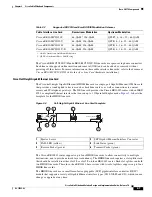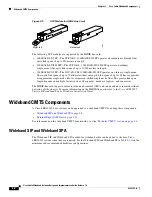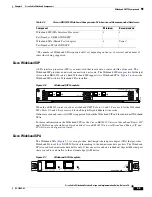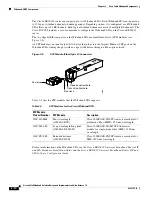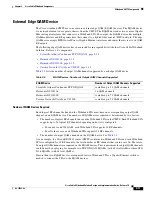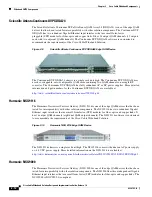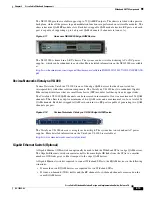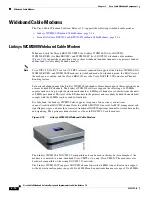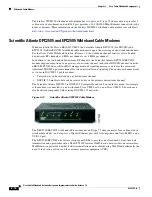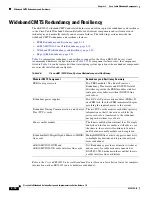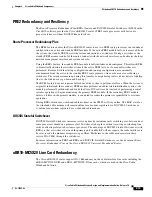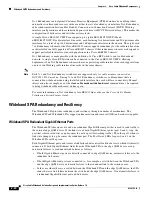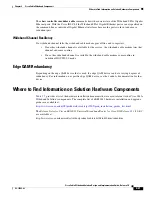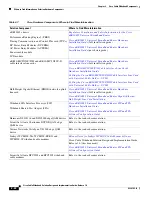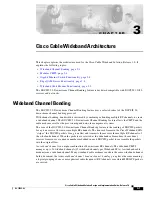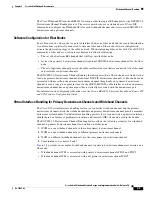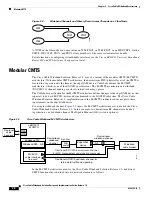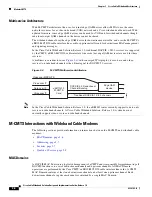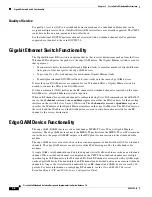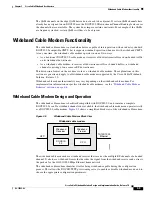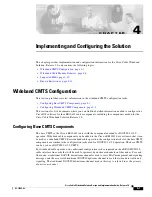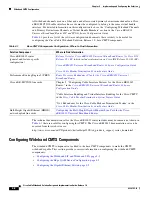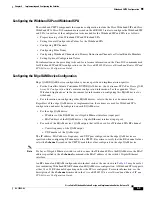
2-20
Cisco Cable Wideband Solution Design and Implementation Guide, Release 1.0
OL-10705-02
Chapter 2 Cisco Cable Wideband Components
Wideband CMTS Redundancy and Resiliency
N+1 Redundancy can help limit Customer Premises Equipment (CPE) downtime by enabling robust
automatic switchover and recovery in the event that there is a localized system failure. N+1 Redundancy
adds synchronization between Hot Standby Connection-to-Connection Protocol (HCCP) Working
interface configurations and those inherited upon switchover to HCCP Protect interfaces. This makes the
configuration of both easier and switchover times faster.
A single Cisco uBR10012 CMTS can support up to eight uBR10-MC5X20S/U/H and
uBR10-MC5X20U-D cable interface line cards, each featuring five downstream and 20 upstream cable
interfaces for a total of up to 40 downstream and 160 upstream interfaces in the chassis. The eight-card
7+1 Redundancy scheme for the Cisco uBR10012 router supports redundancy for the cable interface line
cards installed in a fully populated Cisco uBR10012 chassis. Other redundancy schemes are designed to
support partial cable interface line card populations in a Cisco uBR10012 chassis.
N+1 Redundancy is made possible with the addition of a Cisco RF Switch to your cable headend
network. A single Cisco RF Switch can be connected to the Cisco uBR10012 CMTS, allowing
deployment of an N+1 Redundancy scheme where one protecting cable interface line card supports from
one to seven Working cable interface line cards in the same chassis.
Note
Both 7+1 and N+1 Redundancy switchover are supported
only for cable modems connected as
DOCSIS 1.X/2.0 modems
. During 7+1 and N+1 Redundancy switchover, cable modems that are
connected in wideband mode using the failed cable interface line card will lose connectivity. Manual
intervention (for example, use of the
clear cable modem wideband reset
command) may be required
to bring wideband cable modems w-online again.
For more information on N+1 redundancy for uBR1012 line cards, see the
Cisco Cable Modem
Termination System Feature Guide
.
Wideband SPA Redundancy and Resiliency
The Wideband SPA provides redundancy and resiliency through a number of mechanisms. The
Wideband SIP and Wideband SPAs support online insertion and removal (OIR) and are hot swappable.
Wideband SPA Redundant Gigabit Ethernet Ports
The Wideband SPA has one active and one redundant Gigabit Ethernet port that is used to send traffic to
the external edge QAM device. If the link state of both Gigabit Ethernet ports (port 0 and 1) is up, the
port that is discovered first as up becomes the active port (forwarding traffic). The other port, when its
link state changes to up, becomes the redundant port. The Port Status LEDs for port 0 and 1 on the
Wideband SPA will be green.
Each Gigabit Ethernet port can discover a link failure between itself and the device to which it is directly
connected. If both Gigabit Ethernet links from the Wideband SPA to the edge QAM device are up,
automatic failover to a redundant link behaves as follows:
•
If both Gigabit Ethernet ports are directly connected to edge QAM device, automatic failover to the
redundant link occurs.
•
If both Gigabit Ethernet ports are connected to, for example, a switch between the Wideband SPA
and the edge QAM device, automatic failover to the redundant link to the switch occurs.
•
In the case where there is a switch between the Wideband SPA and the edge QAM device, the SPA
cannot detect a link failure between the switch and the edge QAM device. No automatic failover to
a redundant Gigabit Ethernet port and link occurs.


